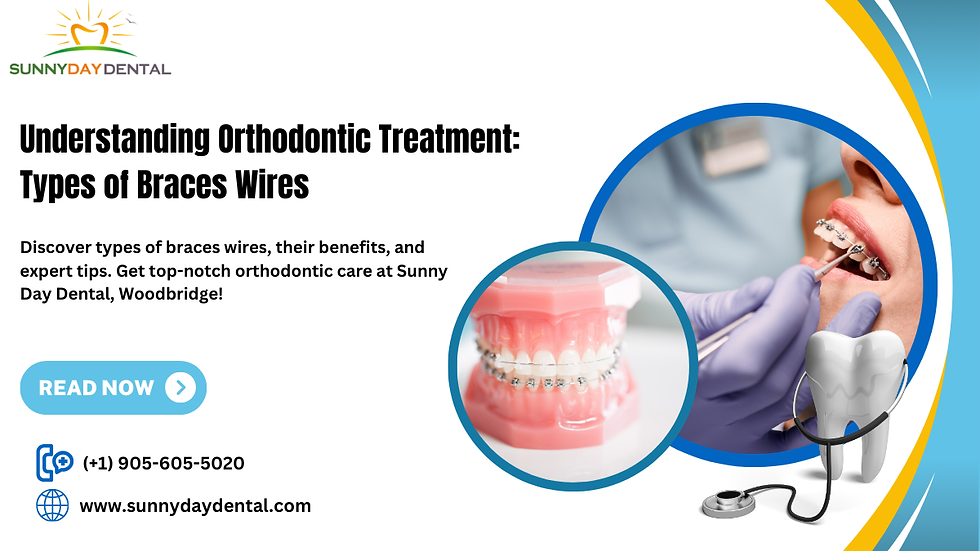Understanding Orthodontic Treatment: Types of Braces Wires
- Sunny Day Dental
- Jan 28
- 4 min read

Orthodontic treatment is a game-changer when it comes to achieving a healthy and confident smile. While most people associate orthodontics with braces, few understand the critical role that braces wires play in the treatment process. In this guide, we’ll explore the types of braces wires, their functions, and how they contribute to the effectiveness of orthodontic treatment.
Whether you’re considering braces or are already undergoing orthodontics in Woodbridge, this blog will provide valuable insights to help you make informed decisions.
What Are Braces Wires and Why Are They Important?
Braces wires, also known as archwires, are thin metal or elastic components that connect the brackets of your braces. They guide your teeth into their desired positions by exerting controlled pressure. The type of braces wire used in your orthodontic treatment can significantly impact the duration, comfort, and efficiency of your treatment.
Types of Braces Wires in Orthodontics
Orthodontists carefully select braces wires based on the patient’s specific needs, treatment phase, and orthodontic goals. Below are the most common types:
1. Stainless Steel Wires
Stainless steel wires are among the most commonly used in orthodontics. They are durable, corrosion-resistant, and provide strong support to move teeth effectively. These wires are ideal for patients requiring significant tooth movement and are often used in the initial stages of treatment.
2. Nickel-Titanium (NiTi) Wires
Nickel-titanium wires are known for their flexibility and ability to return to their original shape after being bent. They are particularly effective during the early stages of orthodontic treatment when teeth need light but consistent pressure to align. NiTi wires are also heat-activated, meaning they respond to body temperature, enhancing their performance.
3. Beta-Titanium Wires
Beta-titanium wires strike a balance between the rigidity of stainless steel and the flexibility of nickel-titanium. They are often used in the mid to late stages of orthodontic treatment when more precise movements are needed. Additionally, beta-titanium wires are gentler on teeth and gums, making them a preferred choice for patients with sensitivity.
4. Aesthetic Wires
For patients who prioritize appearance, aesthetic wires are coated in materials like Teflon or resin to match the color of the teeth or brackets. While not as durable as stainless steel, these wires provide an option for those seeking a discreet orthodontic treatment.
5. Copper Nickel-Titanium Wires
A relatively recent innovation in orthodontics, copper nickel-titanium wires offer enhanced flexibility and temperature responsiveness. These wires are ideal for complex cases, providing effective tooth movement while minimizing discomfort.
How Braces Wires Work in Different Phases of Orthodontic Treatment?
Initial Phase: Flexible wires like NiTi are used to gently align teeth.
Intermediate Phase: Stronger wires such as stainless steel or beta-titanium are introduced to move teeth into precise positions.
Final Phase: Finishing wires fine-tune the alignment and ensure a perfect bite.
Care Tips for Braces Wires
To ensure your orthodontic treatment progresses smoothly, follow these tips:
Avoid sticky or hard foods that could damage your wires.
Use orthodontic wax to alleviate discomfort caused by poking wires.
Brush and floss regularly to maintain oral hygiene and prevent plaque buildup around braces wires.
Visit your orthodontist regularly for adjustments and to replace worn-out wires.
Why Choose Sunny Day Dental for Orthodontics in Woodbridge
At Sunny Day Dental, we understand that every patient’s orthodontic needs are unique. Our expert team offers tailored orthodontic treatment using advanced technology and high-quality materials. From traditional braces to modern alternatives, we’re here to guide you through every step of your journey to a confident smile.
What Are the Types of Braces Wires?
Braces wires are the backbone of orthodontic treatment, guiding teeth into alignment. Types include stainless steel, nickel-titanium, beta-titanium, aesthetic wires, and copper nickel-titanium, each serving a specific purpose for effective results.
Book Your Free Consultation
Ready to transform your smile? Sunny Day Dental in Woodbridge offers personalized orthodontic treatment tailored to your needs. From understanding the types of braces wires to creating a seamless treatment plan, we’re here to support you every step of the way. Book your consultation today at Sunny Day Dental.
FAQs About Types of Braces Wires
1. What is the purpose of braces wires in orthodontic treatment?
Braces wires connect the brackets and apply controlled pressure to guide teeth into their desired positions, ensuring proper alignment and bite correction.
2. How often are braces wires changed during treatment?
Typically, braces wires are adjusted or replaced every 6–8 weeks during routine orthodontic check-ups to ensure continuous progress.
3. Are there braces or wires that reduce discomfort?
Yes, wires like nickel-titanium and beta-titanium are designed to provide gentle and consistent pressure, minimizing discomfort during treatment.
4. Can I choose aesthetic wires for a more discreet look?
Absolutely! Aesthetic wires are coated to match your teeth or brackets, offering a less noticeable option for orthodontic treatment.
5. What should I do if my braces wire breaks?
If a wire breaks or pokes your gums, apply orthodontic wax for temporary relief and schedule an appointment with your orthodontist immediately.




Comments